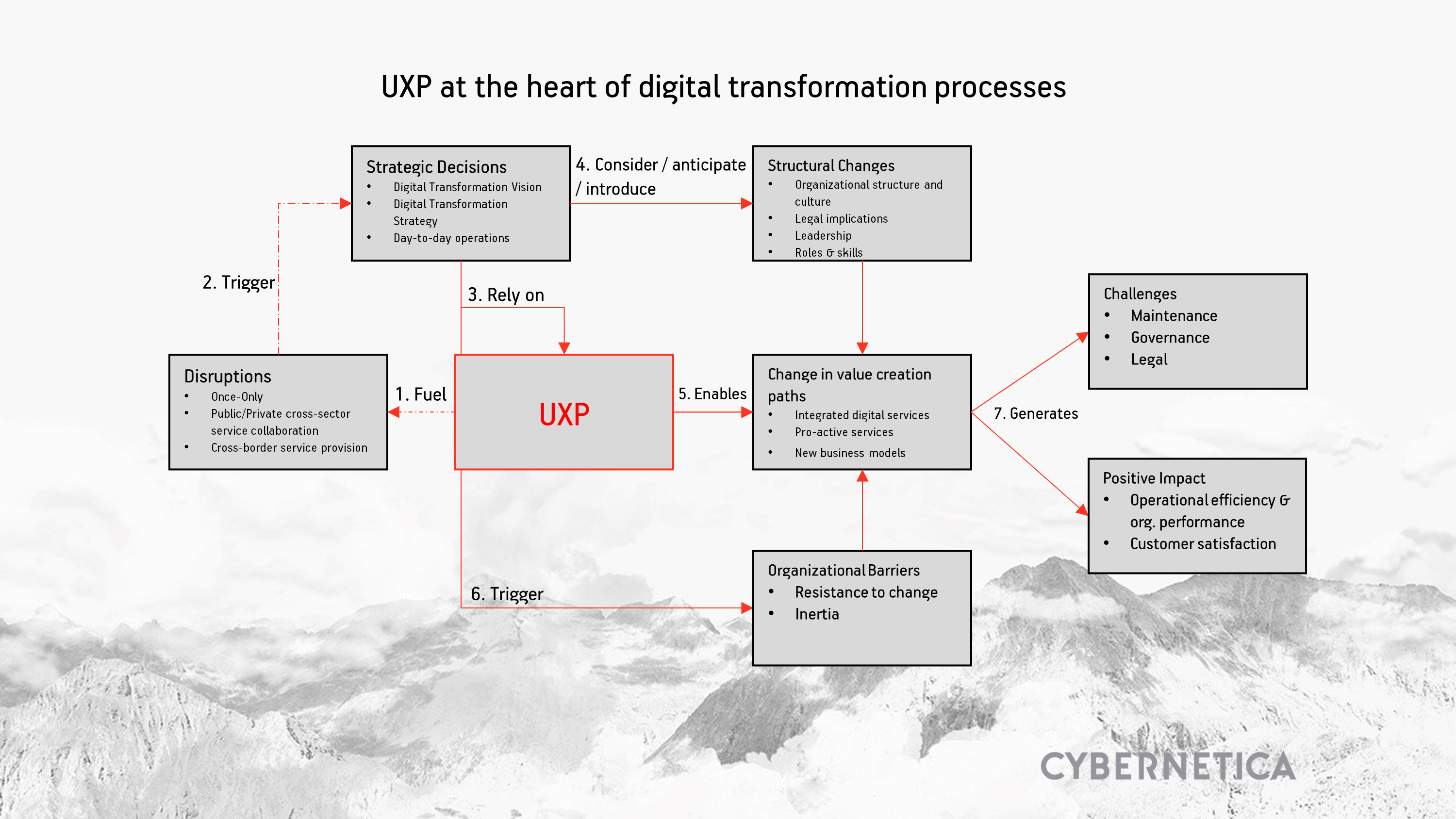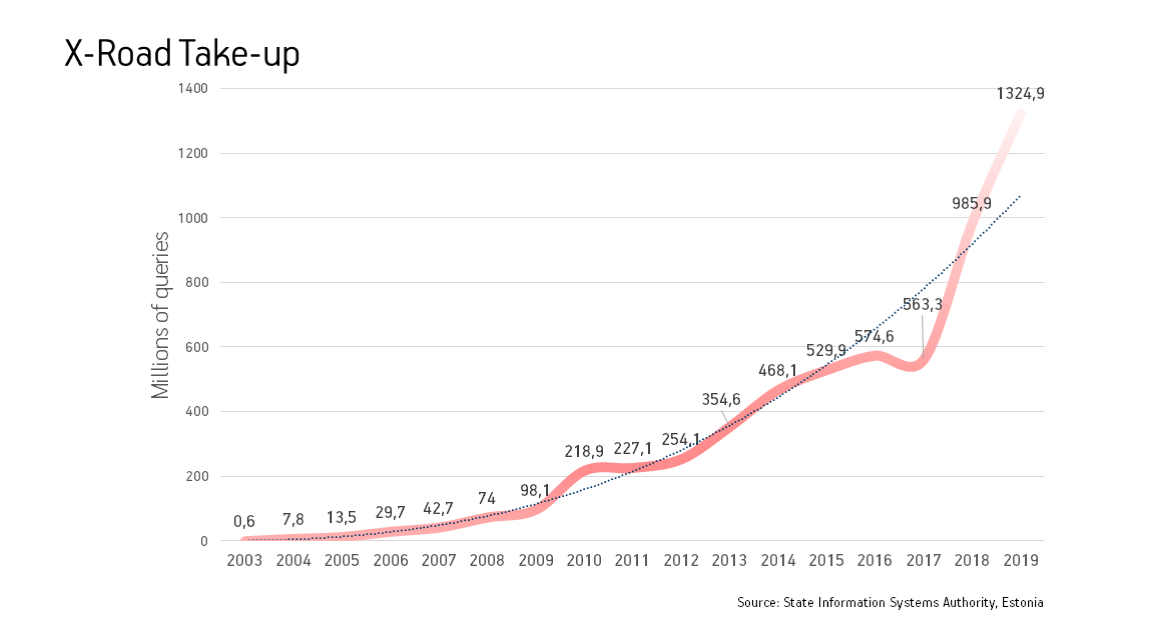In the first blog post of this series, I took a closer look at what digital transformation means and outlined the areas that are crucial to address when continuously transforming business or government operations based on UXP. Today, in the third and final post, I’ll address these from the perspective of the Governing Authority and other stakeholders.

Based on Vial, Gregory: Understanding digital transformation: A review and a research agenda, in: Journal of Strategic Information Systems Review, Volume 28, Issue 2, June 2019, Pages 118-144
Leadership, Ownership and Communication
UXP is a very sophisticated and highly scalable, dynamic, interoperability platform for integrating business processes and services. However, it must be kept in mind that the promise of integrating different independent stakeholder’ databases does come with a rather disruptive impact on stakeholders’ usual operations. Essentially, a UXP member is opening up what’s most dear to them to another party. Achieving that requires finesse and skills on behalf of the management of the Governing Authority (and the UXP members).
It requires vision and leadership to move a project with these kinds of implications forward. Leadership doesn’t just mean managing the practical introduction of new technology, but it actually means taking ownership of both the vision, its disruptive implications and the technology. The Why introduce data exchange technology is of crucial importance: data exchange technology allows fulfilling the vision of creating more administration- and user-friendly business processes and services across sectoral and organisational borders. That’s groundbreaking and needs motivating leadership in order to make that kind of project a success.
Thus, the more involved the Governing Authority (GA) is in leading the transformation with all its aspects, the easier it will be to scale the data exchange platform for significant business impact. In addition to ownership and leadership, the data exchange layer certainly needs clear communication around it. Vision and mission statement of a UXP deployment can become a central point of reference and inspiration for both the Governing Authority and other stakeholders. However, unless the people within the respective entities don’t know about vision and mission, it’s going to be hard for them to understand the technology’s impact on their work and even harder to further communicate it enthusiastically.
Apart from vision and mission, training staff - not only about the technology, but the wider, general scope, too - can be really helpful for achieving success. The overall impact of the technology on the operational level is necessary for the staff to understand what societal mission they are working on. It’s not just another piece of software, but it allows for something that goes way beyond a single system admin’s user interface.
Short-Term Wins
During such a transformative project, it’s a good idea to create short-term wins for the staff of the GA but also other stakeholders. Short-term wins are stepping stones to fulfilling the long-term vision. The most well-known and researched case of successful nationwide implementation of UXP core technology is, of course, the Republic of Estonia, where the technology originally comes from. The initial layer, built by Cybernetica, was launched in 2001. Its usage and integration into nationwide administrative processes came gradually over time and is currently close to one billion queries over the data exchange layer.

The diagram illustrates very well, that the usage of the data exchange layer has gradually increased over a significant time period. Thus, it becomes clear that short-term wins are needed to keep the vision in sight, report success to other stakeholders and motivate the people involved. Short-term wins also allow to feel good about the potential sacrifices that have come with the introduction of the new technology and business processes. In addition, a healthy culture of constructive feedback allows to re-align vision and strategy around the implementation of the data exchange layer.
Building Alliances
The factors mentioned previously are all particularly relevant for the internal change processes ongoing within both GA and UXP Member organisations. The following two factors more generally address the successful digital transformation of public or business administration based on UXP.
Scaling the impact and success of the data exchange layer depends on the UXP Members' commitment to exchange data via UXP. While UXP software provides great technical arguments for its use, it is up to the Governing Authority to provide the management arguments to convince entities to use this software for business process optimisation and cross-organisational collaboration. Usually, critical mass is required to activate UXP’s full potential, thus the management of the Governing Authority actively needs to build alliances with the management of potential UXP Members and maybe even help them identify potential use cases for faster adoption.
Building alliances begins with external communication: informing either public or private entities about the possibility to join the data exchange layer, its benefits and the overall vision and scope of the project. External communication should promote becoming a member of UXP in order to be a first mover and get access to UXP skills right away. First movers can be strategically important as they can publicly endorse the project and its implications. The wider the alliance and support for the project, the more likely it will succeed. The alliance should also remain intact during the project and follow the before-mentioned short-win paradigm: define short-term and medium-term objectives in order to continuously reflect on the data exchange layer’s general progress.
Creating Incentives
People generally react sceptically to change and it’s sometimes helpful to nudge them into the right direction. One way to do that, if possible, is actually to make the use of UXP data exchange technology mandatory in government deployment. While it is probably challenging to introduce this kind of obligation and hard to achieve right from the beginning, it’s likely to make a major difference in the long run, as the member organisations will understand that the earlier they educate themselves on data exchange, the better. Arguably, the introduction of the once-only principle in Estonia, which specifies that personalised datasets are only to be kept by one respective legally entitled entity, had its impact on the increased use of the data exchange layer: suddenly government entities were legally obliged to exchange data rather than duplicate it and the tool for that was the data exchange technology.
If making the use of UXP mandatory is not an option, the aforementioned alliance becomes even more important to get other stakeholders and potential members on board in order to innovate the use cases and business models to be built on top of the data exchange layer. In that case it would certainly be an option to work with incentives to get new members on board such as free trials, free trainings, flexible payment plans etc. The latter model can both apply to governmental and non-governmental deployments and eventually the approach to incentivising says quite a bit about the GA’s or stakeholders' commitment to making this project a success: the more they believe in their project, the more they are probably willing to invest in order to activate its full potential.
Certainly, there is more to consider along the way, but you’re always welcome to reach out to us. We can help you with advisory services for your UXP-backed digital transformation. Read more about it here: https://cyber.ee/products/secure-data-exchange/advisory/
Written by Tobias koch
Reference: Vial, Gregory: Understanding digital transformation: A review and a research agenda, in: Journal of Strategic Information Systems Review, Volume 28, Issue 2, June 2019, Pages 118-144